James B. Conant facts for kids
Quick facts for kids
James B. Conant
|
|
|---|---|
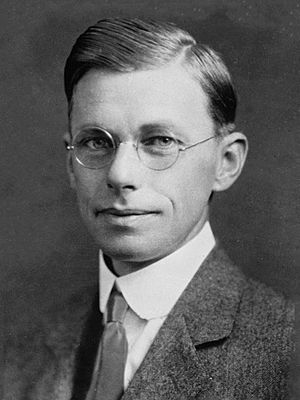
Conant in 1932
|
|
| 1st United States Ambassador to West Germany | |
| In office May 14, 1955 – February 19, 1957 |
|
| President | Dwight D. Eisenhower |
| Preceded by | Leland B. Morris (as chargé d'affaires, 1941) |
| Succeeded by | David K. E. Bruce |
| 23rd President of Harvard University | |
| In office 1933–1953 |
|
| Preceded by | Abbott Lawrence Lowell |
| Succeeded by | Nathan Marsh Pusey |
| Personal details | |
| Born |
James Bryant Conant
March 26, 1893 Dorchester, Massachusetts, U.S. |
| Died | February 11, 1978 (aged 84) Hanover, New Hampshire, U.S. |
| Relations | Jennet Conant (granddaughter) James F. Conant (grandson) |
| Education | Harvard University (AB, PhD) |
| Awards | American Institute of Chemists Gold Medal (1934) Commandeur, Légion d'honneur (1936) Benjamin Franklin Medal (1943) Priestley Medal (1944) Medal for Merit (1946) Kentucky colonel (1946) Honorary Commander of the Order of the British Empire (1948) Grand Cross of the Order of Merit of the Federal Republic of Germany (1957) Presidential Medal of Freedom with Distinction (1963) Sylvanus Thayer Award (1965) Clark Kerr Medal (1977) Fellow of the Royal Society |
| Signature | |
| Military service | |
| Allegiance | |
| Branch/service | Chemical Warfare Service |
| Years of service | 1917–1919 |
| Rank | |
| Battles/wars | World War I |
| Scientific career | |
| Fields | Organic chemistry |
| Thesis | A study of certain cyclopropane derivatives; the electromotive force of sodium amalgam concentration cells. (1916) |
| Doctoral advisors | Elmer Peter Kohler Theodore William Richards |
| Doctoral students | Louis Fieser Paul D. Bartlett Alwin Max Pappenheimer Jr. Frank Westheimer |
James Bryant Conant (born March 26, 1893 – died February 11, 1978) was an important American chemist and a leader in education and government. He was the president of Harvard University for 20 years. Later, he became the first U.S. Ambassador to West Germany.
Conant earned a PhD in chemistry from Harvard in 1916. During World War I, he worked for the U.S. Army to develop poison gases. After the war, he became a chemistry professor at Harvard. He studied how chemicals react and helped explain the structure of important natural substances like chlorophyll. He also made discoveries about acid-base chemistry.
In 1933, Conant became the President of Harvard University. He made many changes, like getting rid of class rankings and requiring Latin classes. He also stopped athletic scholarships. Conant believed in giving more students a chance to attend Harvard. He helped bring in the Scholastic Aptitude Test (SAT) and allowed women to attend Harvard Medical School and Harvard Law School for the first time.
During World War II, Conant led important research projects for the government. He oversaw the creation of synthetic rubber and the Manhattan Project, which developed the first atomic bombs. He was there for the first atomic bomb test in 1945. After the war, he advised President Harry S. Truman on using atomic bombs.
After leaving Harvard in 1953, Conant became the United States High Commissioner for Germany. He helped Germany regain its independence after World War II. He then served as the U.S. Ambassador to West Germany until 1957. When he returned to the U.S., he wrote books criticizing the American education system. He passed away in 1978.
Contents
Early Life and Education
James Bryant Conant was born in Dorchester, Massachusetts, on March 26, 1893. He was the third child and only son of James Scott Conant, who was a photoengraver, and Jennett Orr.
In 1904, Conant passed a tough exam to get into the Roxbury Latin School. He graduated near the top of his class in 1910. His science teacher, Newton H. Black, encouraged him to study science.
In September 1910, Conant started at Harvard College. He studied physical chemistry and organic chemistry. He also worked as an editor for The Harvard Crimson, the student newspaper. He graduated with his bachelor's degree in June 1913.
Conant then continued his studies to earn his Doctor of Philosophy degree. He wrote two dissertations, which was unusual. Harvard gave him his PhD in 1916.
In 1915, Conant started a business with two other Harvard chemistry graduates. They made chemicals for medicines. However, in 1916, an explosion destroyed their factory. Conant accepted an offer to return to Harvard as a chemistry professor.
World War I Service
When the United States joined World War I in 1917, Conant joined the U.S. Army. He was a second lieutenant. He worked on developing poison gases.
His work first focused on mustard gas. In May 1918, Conant led a team that developed lewisite, another type of chemical weapon. He was promoted to major. A factory was built to make lewisite, but the war ended before it could be used in battle.
Harvard Chemistry Professor
Conant became an assistant professor of chemistry at Harvard in 1919. In 1920, he married Grace (Patty) Thayer Richards, the daughter of his former professor. They had two sons, James Richards Conant and Theodore Richards Conant.
He became an associate professor in 1924. In 1925, he traveled to Germany for eight months. Germany was a world leader in chemical research at the time. He visited many universities and met famous chemists.
When he returned, another university tried to hire him. Harvard's president offered him a promotion to full professor and money for his research. Conant accepted and stayed at Harvard. In 1931, he became the head of the chemistry department.
Between 1928 and 1933, Conant published many scientific papers. His research often combined the study of natural products with how chemicals react. He was one of the first to understand that the speed of chemical reactions can be simple or very complex.
Conant's work helped us better understand acids and bases. He studied very strong acids, which he called "superacids." His research helped develop modern ideas about acids and bases.
He also studied chlorophyll, the green pigment in plants. His work helped other scientists figure out its full structure. In 1941, he became a foreign Fellow of the Royal Society because of his work on chlorophyll. He also studied how to make synthetic rubber.
Another area of his research was the biochemistry of hemoglobin, the protein in blood that carries oxygen. He found that a problem with the iron in hemoglobin causes a medical condition called methemoglobinemia.
Conant wrote a popular chemistry textbook called Practical Chemistry with his former teacher, Newton Black. It was used by many universities. For his achievements in chemistry, he received several awards, including the Priestley Medal in 1944.
Leading Harvard University
On May 8, 1933, James Conant was chosen to be the next President of Harvard. He was the 23rd president. His inauguration ceremony was simple, showing his desire for informality and change.
Conant made many reforms at Harvard:
- He tried to get rid of the special degrees for students who studied Latin.
- He stopped class rankings.
- He ended athletic scholarships.
- He started an "up or out" policy for professors. This meant professors had to earn promotions or leave.
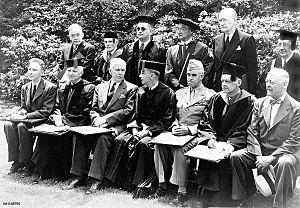
Conant also added new graduate degrees in different subjects. He created the Nieman Fellowship for journalists to study at Harvard. He wanted to help students from less privileged backgrounds. He started national scholarships for these students.
He asked his deans to check if the Scholastic Aptitude Test (SAT) was a good way to measure how well students would do in college. When they said yes, Conant adopted it for Harvard. He also helped create the Educational Testing Service in 1946, which runs the SAT.
Conant also changed how classes were taught. Instead of separate classes for Harvard men and Radcliffe College women, he started co-educational classes. During his time, women were first allowed into Harvard Medical School in 1945 and Harvard Law School in 1950.
In 1934, a German businessman named Ernst Hanfstaengl, who supported the Nazis, offered money for a scholarship at Harvard. Conant refused the money because of Hanfstaengl's Nazi connections. Conant also spoke out against the Nazi threat to academic freedom.
In 1936, Harvard celebrated its 300th anniversary. President Franklin D. Roosevelt attended and spoke at the event. Conant approved of Roosevelt's goals for the country.
National Defense Research Committee
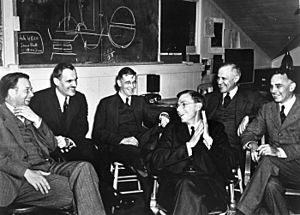
In June 1940, as World War II was happening in Europe, Vannevar Bush asked Conant to join the National Defense Research Committee (NDRC). Conant remained Harvard's president at the same time. The NDRC brought scientists together to do research for the war effort. Conant believed that Nazi Germany had to be stopped and that the U.S. would join the war.
Conant became the head of the NDRC's Division B, which worked on bombs, fuels, gases, and chemicals. In 1941, the Office of Scientific Research and Development (OSRD) was created, and Conant became the chairman of the NDRC, which became part of the OSRD. The NDRC was also asked to study nuclear fission.
In February 1941, Conant went to Britain to see their research and discuss working together. He met Prime Minister Winston Churchill and even King George VI. He learned about Britain's progress in developing an atomic bomb. This made Conant think that Germany might be even further ahead.
Later, Conant tried to limit cooperation with Britain on nuclear energy. But President Roosevelt and Churchill agreed to full cooperation in 1943. After the U.S. entered the war, the OSRD gave the atomic bomb project, known as the Manhattan Project, to the Army. Conant remained involved in leading the project.
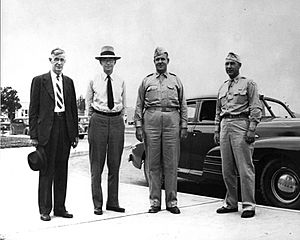
In 1942, Conant was appointed to the Rubber Survey Committee. This committee was formed because the war cut off 90 percent of the natural rubber supply. Developing synthetic rubber became very important. Conant focused on the technical challenges. The committee recommended building 51 factories to make synthetic rubber. By late 1944, these factories were producing over a million tons of synthetic rubber each year.
In May 1945, Conant joined the Interim Committee. This group advised the new president, Harry S. Truman, about nuclear weapons. The committee decided that the atomic bomb should be used against a target in Japan without warning. On July 16, 1945, Conant was present at the Trinity nuclear test, the first time an atomic bomb was exploded.
After the war, Conant helped explain why the atomic bombs were used on Japan. He played a role in shaping public opinion by helping to write an article in Harper's Magazine in 1947. The article said the bombings were used to avoid "over a million casualties" from a possible invasion.
Cold War Era
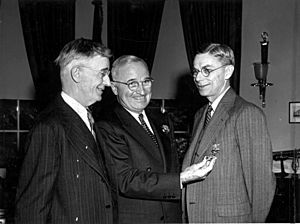
In 1947, the Atomic Energy Act of 1946 created the United States Atomic Energy Commission (AEC) to manage nuclear energy. It also set up the General Advisory Committee (GAC) to give scientific advice. Conant was expected to lead the GAC, but Robert Oppenheimer became its chairman instead.
Conant also worked on coordinating defense research. When concerns were raised about Oppenheimer's past connections, Conant and Bush supported him, saying they knew about it when they put him in charge of Los Alamos.
Conant believed that public education was very important for American democracy. He called for more government spending on education. He wrote books like Education in a Divided World (1948) and Education and Liberty (1951) about his ideas.
Conant's influence began to decrease in the early 1950s. He and Oppenheimer opposed developing the hydrogen bomb, but President Truman decided to go ahead with it. This reduced the GAC's importance. Conant was appointed to the National Science Board, which managed the new National Science Foundation, but it had less power.
Conant believed the public needed to understand science better. He started teaching a new course at Harvard called "On Understanding Science." His notes from this course became a book. He also wrote Science and Common Sense to explain science to everyday people.
U.S. High Commissioner in Germany
In 1951, Conant was asked to become the United States High Commissioner for Germany. He first declined, but when Dwight Eisenhower became president in 1952, Conant was offered the job again and accepted. He announced he would retire from Harvard in September 1953.
In Germany, Conant faced big challenges. Germany was still occupied by the U.S., Soviet Union, Britain, and France. West Germany had gained control of its own affairs in 1949, but not its defense or foreign policy. The U.S. wanted to rearm Germany to reduce its own defense spending.
A major event during Conant's time was the uprising of 1953 in East Germany. This brought up the issue of reuniting Germany. Conant worked to get the European Defense Community approved, which would have created a joint European military. This plan failed, but it led to West Germany joining NATO with its own army.
On May 6, 1955, Conant and the high commissioners from Britain and France signed documents ending Allied control of West Germany. This allowed West Germany to join NATO and rearm. Conant then became the first United States Ambassador to West Germany. He spoke German fluently and visited many German schools and science groups.
Later Life and Legacy

Conant returned to the United States in February 1957. From 1957 to 1965, he received money to write studies about education. In 1959, he published The American High School Today, also known as the Conant Report. This book became a bestseller and led to many school reforms across the country. He suggested combining high schools into larger ones to offer more classes.
His next book, Slums and Suburbs (1961), discussed racial issues in schools. He suggested accepting schools that were separated by race, which was not popular with civil rights groups. By 1964, Conant admitted he had been wrong. In The Education of American Teachers (1963), he criticized how teachers were trained.
President Lyndon Johnson gave Conant the Presidential Medal of Freedom in December 1963. President Richard Nixon also gave him the Atomic Pioneers Award in 1970. Conant received many other awards, including honors from France, Britain, and Germany. He also received over 50 honorary degrees.
Between 1965 and 1969, Conant wrote his autobiography, My Several Lives. He became increasingly ill and had several strokes in 1977. He passed away in a nursing home in Hanover, New Hampshire, on February 11, 1978. His ashes were buried in Mount Auburn Cemetery.
Conant left a sealed letter for the Harvard President of the 21st century. When it was opened in 2007, he expressed his hopes for Harvard's future. He wrote that he was sure Harvard would "maintain the traditions of academic freedom, of tolerance for heresy."
Two schools are named after him: James B. Conant High School in Hoffman Estates, Illinois, and James B. Conant Elementary School in Bloomfield Hills, Michigan.
Images for kids
See also
 In Spanish: James Bryant Conant para niños
In Spanish: James Bryant Conant para niños

